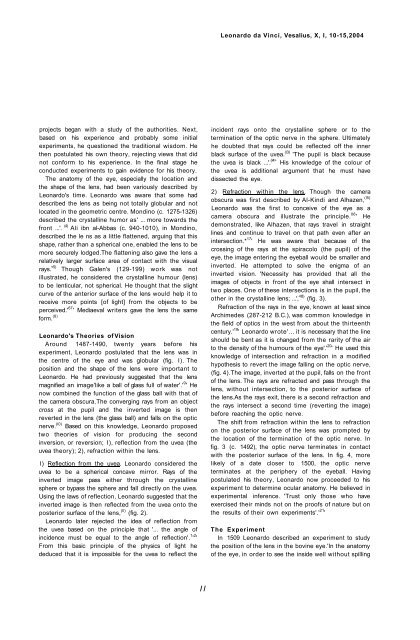Leonardo da Vinci, Visual Perspective and the Crystalline Sphere ...
Leonardo da Vinci, Visual Perspective and the Crystalline Sphere ...
Leonardo da Vinci, Visual Perspective and the Crystalline Sphere ...
You also want an ePaper? Increase the reach of your titles
YUMPU automatically turns print PDFs into web optimized ePapers that Google loves.
<strong>Leonardo</strong> <strong>da</strong> <strong>Vinci</strong>, Vesalius, X, I, 10-15,2004projects began with a study of <strong>the</strong> authorities. Next,based on his experience <strong>and</strong> probably some initialexperiments, he questioned <strong>the</strong> traditional wisdom. He<strong>the</strong>n postulated his own <strong>the</strong>ory, rejecting views that didnot conform to his experience. In <strong>the</strong> final stage heconducted experiments to gain evidence for his <strong>the</strong>ory.The anatomy of <strong>the</strong> eye, especially <strong>the</strong> location <strong>and</strong><strong>the</strong> shape of <strong>the</strong> lens, had been variously described by<strong>Leonardo</strong>'s time. <strong>Leonardo</strong> was aware that some haddescribed <strong>the</strong> lens as being not totally globular <strong>and</strong> notlocated in <strong>the</strong> geometric centre. Mondino (c. 1275-1326)described <strong>the</strong> crystalline humor as' ... more towards <strong>the</strong>front ...'. (4) Ali ibn al-Abbas (c. 940-1010), in Mondino,described <strong>the</strong> le ns as a little flattened, arguing that thisshape, ra<strong>the</strong>r than a spherical one, enabled <strong>the</strong> lens to bemore securely lodged.The flattening also gave <strong>the</strong> lens arelatively larger surface area of contact with <strong>the</strong> visualrays. His knowledge of <strong>the</strong> colour of<strong>the</strong> uvea is additional argument that he must havedissected <strong>the</strong> eye.2) Refraction within <strong>the</strong> lens. Though <strong>the</strong> cameraobscura was first described by Al-Kindi <strong>and</strong> Alhazen, (l5)<strong>Leonardo</strong> was <strong>the</strong> first to conceive of <strong>the</strong> eye as acamera obscura <strong>and</strong> illustrate <strong>the</strong> principle. 06 ' Hedemonstrated, like Alhazen, that rays travel in straightlines <strong>and</strong> continue to travel on that path even after anintersection.* 17 ' He was aware that because of <strong>the</strong>crossing of <strong>the</strong> rays at <strong>the</strong> spiracolo (<strong>the</strong> pupil) of <strong>the</strong>eye, <strong>the</strong> image entering <strong>the</strong> eyeball would be smaller <strong>and</strong>inverted. He attempted to solve <strong>the</strong> enigma of aninverted vision. 'Necessity has provided that all <strong>the</strong>images of objects in front of <strong>the</strong> eye shall intersect intwo places. One of <strong>the</strong>se intersections is in <strong>the</strong> pupil, <strong>the</strong>o<strong>the</strong>r in <strong>the</strong> crystalline lens; ...',
















